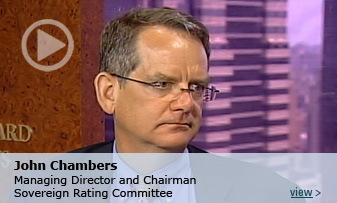Tổ chức Moody’s từ năm 1917 áp điểm tín dụng tốt nhất thế giới còn gọi là điểm tín dụng vàng– -AAA-cho tín nhiệm khả năng trả nợ của Hoa Kỳ. Và thế giới vẫn tiếp tục nhìn nhận giá trị tín dụng vàng này của Mỹ cho đến ngày 5-8-2011, Standard & Poors, một trong 3 tổ chức có khả năng xếp hạng tín dụng hàng đầu thế giới, lần đầu tiên hạ điểm tín nhiệm nợ của Mỹ xuống duới tiêu chuẩn vàng-từ AAA xuống AA+.

Đây là một thông tin xấu cho toàn thế giới, nhất là Châu Á vì Trung Quốc và Nhật là 2 quốc gia chủ nợ lón nhất, nhì của Hoa Kỳ. Trong thực tế, tổ chức Standard & Poors -S&P- trước đó đã từng cảnh báo sẽ hạ mực tín nhiệm nợ của Mỹ nếu chính phủ Mỹ không đạt được thỏa thuận giảm quốc trái ít nhất $4000 tỷ trong vòng 10 năm tới.
Phản ứng đầu tiên là Bộ Tài Chánh Hoa Kỳ cho rằng S&P đã tính sai đến $2000 tỷ trong cách tính của họ về sự thâm hụt ngân sách của Hoa Kỳ. Tổ chức S&P thừa nhận có sư tính sai đó nhưng S&P vẫn giữ nguyên quyết định trên vì lý do chủ chốt S&P hạ điểm tín nhiệm nợ của Hoa Kỳ là sự suy đồi tình hình, phong cảnh chính trị của Hoa Kỳ- Political Climate- trong những tháng qua xuyên qua cuộc tranh cãi, đấu đá giằng co nâng mức trần quốc trái của Hoa Kỳ, nhất là nhóm Tea Party của bà Paline thuộc đảng Công Hòa, quyết định không muốn nâng trần quốc trái, đưa nước Mỹ vào đường vỡ nợ. Cũng trong chiều hướng thẩm định đó, tổ chức S&P cho hay mức tín nhiệm nợ của HoaKỳ có thể bị đánh tuột hạng thêm một lần nữa trong khoảng 18-24 tháng tới.
Theo số liệu tài chánh Mỹ trong tuần qua, quốc trái Mỹ đã chạm mức $14,600 tỷ tương đương 100% GDP. Tổng chi một tháng của chính phủ Mỹ cao hơn tổng thu một tháng của c/p Mỹ là $200 tỷ. Và như thế là cứ mỗi đô la chính phủ tiêu là có 40 cents tiền đi vay.
Ngay sau thông tin S&P đánh sụt điểm tín nhiệm khả năng trả nợ của Mỹ xuống đến mực AA+, lập tức chứng khóan Á Châu mất điểm:
– Chỉ số Nikkei của Tokyo mất 3.72% tương đượng mất -359 điểm
– Chỉ số Hàng Sinh HongKong giảm 4% tương đương mất -939 điểm.
– Giá Cổ phiếu ở Thương Hải, Sidney, Mumbai, Singapore, Kuala Lumpur, Bangkok, Jakarta, Manila, Đài Bắc, Hán Thành đều giảm…
Chứng khoán Á Châu vẫn tiếp tục rơi ngày càng sâu hơn…
Trong khi đó chứng khoán ở Âu châu xem chừng chưa hứng chịu ảnh hưởng, phần nhiều còn ổn, – Chỉ có chỉ số London giảm 2%,
– Chỉ số Frankfurt Đức, giảm 1.6%.
Tuy nhiên, cùng ngày 5/8 Dow Jones của Mỹ đã ngoi lên +61 điểm trước giờ đóng cửa sau khi mất -513 điểm vào ngày hôm trước, thứ năm 4-8-11; và Mỹ cũng đạt được 117,000 jobs hồi tháng7, kéo tỉ lệ thất nghiệp xuống còn 9.1%. Chính sự tăng trưởng bất ngờ này của Mỹ đã phục hồi hai chỉ số bị tuột giảm của London và Frankfurt vừa kể trên.
Nhưng đến ngày thứ hai 8-8-11, Dow Jones, Nasdaq, SGP… và chứng khoán Âu châu, theo gót chứng khóang Á châu rơi mất nhiều điểm. Lúc 12:00 trưa, Chicago, ngày 8-8-11
– DOW JONES mất -554 điểm tương đương 4.7%,
– NASDAQ mất-154 tương đương 6.14%,
– SGP500 mất -70,31 tương đương với 5.18%.
– FREDDIE MEA và FANNIE MEA cũng bị S&P hạ thắp điểm tín dụng hôm thứ hai 8-8-11 vì hai tổ chức này có liên hệ đế vấn đề quốc trái của Mỹ.
Châu Âu cũng chung số phận với chứng khoán Châu Á:
-Chứng khoáng Anh FTSE 100 mất 2.7%,
– Đức DAX mất 4.7%,
– Pháp CAC mất 4.2%….
– Chứng khoán Greece, Italia, Potugual, Espagne, Ireland còn tệ hại hơn nữa. Chứng khoán các quốc gia này vốn dĩ xuống cấp từ lâu…
Việc S&P đánh hạ điểm tín dụng nợ của Mỹ đồng nghĩa việc nợ Mỹ giờ này trở nên kém an toàn. Giới đầu tư có thể đòi mức lãi suất cao hơn đối với trái phiếu của Bộ Tài chánh Mỹ. Do đó Mỹ có nhiều khả năng phải trả đến $75tỷ mỗi tháng cho lãi suất quốc trái thay vì chỉ trả $250 tỷ mỗi năm như hiện nay. Không phải riêng chính phủ, những doanh nghiệp, tư nhân Mỹ sẽ gặp khó khăn trong việc đi vay vì phải trả lãi suất cao hơn.
Các nước châu Á có giao dịch thương mại với Mỹ đều đạt thương mại thặng dư, thu về lượng USD rất lớn và đổ dồn đầu tư vào trái phiếu Hoa Kỳ. Do đó bất cứ biến động nào của kinh tế Mỹ cũng sẽ gây ra hậu quả nghiêm trọng đến nền kinh tế của các nước Châu Á này. Theo Tân Hoa Xã, tính đến tháng 4-2011, TQ nắm giữ 1150 tỷ USD nợ (IOY) , Nhật nắm gần 1000 tỷ USD nơ (IOY) dưới hình thức trái phiếu của Bộ Tài Chánh Mỹ
Nóng mặt vì những xáo trộn trên, Tân Hoa Xã hôm thứ sáu lên tiếng chỉ trích Mỹ dữ dội gọi Mỹ là “con nghiện nợ ”và chỉ trích những đấu đá tranh cãi thiển cận của Quốc Hội Mỹ. Thừa cơ hội, THX cho rằng đã đến lúc thế giới cần loại ngoại tệ mới ổn định hơn. Trong lúc đó các lãnh đạo ngân hàng Trung Ương, Quốc Gia TQ cho rằng đồng Đô la sẽ tiếp tục mất giá nhiều hơn nữa trong tương lai. Họ lên tiếng tố cáo đồng đô la, đồng tiền không ổn định.
Trong lúc đó, Bộ trưởng tài chánh của Seoul, Yim Joy yong, cũng cảnh báo nền kinh tế Nam Triều Tiên có thể bị ảnh hưởng trong thời gian trước mắt. Nhật lúc nào cũng bày tỏ sự tin tưởng vào Mỹ. Hôm 8-8 Bộ trưởng tài chánh Nhật, Yoshihiko Nodo, tuyên bố với báo chí :”Niềm tin của chúng tôi đặt vào trái phiếu của Mỹ sẽ không thay đổi”. Một số quốc gia và các nhà đầu tư Châu Á cho rằng họ sẽ tiếp tục đầu tư vào nợ Mỹ bởi vì không có nguồn đầu tư nào khác xứng đáng thay thế nợ Mỹ.
Hôm thứ Bảy, 6-8-11 Nga tuyên bố: Nga tiếp tục đầu tư vào nợ Mỹ vì Nga tin tưởng điểm tin dụng Mỹ vẫn ổn định. Trị giá tín dụng AAA và AA+ trong thực tế không khác nhau như người ta tưởng. Châu Âu, nói chung lúc nào cũng đứng sau Mỹ, lúc nào cũng ủng hộ đồng đôla cũng như đồng đô la lúc nào cũng ủng hộ đồng Euro trong việc tranh thủ địa vị trong rỗ tiền dự trữ thế giới với đồng Yuan của TQ. Và chính phủ Trung Quốc cũng dư biết điều này…
Động thái của S&P hạ điểm tín nhiệm khả năng trả nợ của Mỹ, theo Timothy Geithner, Bộ Trưởng Tài chánh Hoa Kỳ, là một phán xét tệ hại-terrible judgment- Nhưng sư thật động thái của S&P như một cơn phong ba quét qua mặt địa cầu làm đảo lộn trốc gốc hầu hết các thị trường chứng khoán phơi bày mọi mặt yếu kém của nền kinh tế tài chánh thế giới hiện tại cần phải được phục hồi. Hành động của tổ chức S&P phải được lịch sử đánh giá cao vì nó nói lên được tính trung thực, công bằng và hoàn toàn độc lập với nhà nước với thế lực đến bất cứ từ đâu. Nhìn từ dưới gốc độ này, Tổ chức S&P xứng đáng với sự tin tưởng của nhân loại, của toàn thể công dân Mỹ. Hy vọng, qua bài học lịch sử này, nước Mỹ sẽ vùng đứng lên trong “Thời Đại Barack Obama”, cải tổ và hoàn thiện nền kinh tế Mỹ. Nước Mỹ tiếp tục lãnh đạo kinh tế toàn cầu.
Đào Như
Oak Park, Illinois, USA

WASHINGTON — Standard & Poor’s removed the United States government from its list of risk-free borrowers for the first time on Friday night, a downgrade that is freighted with symbolic significance but carries few clear financial implications.
Multimedia
The company, one of three major agencies that offer advice to investors in debt securities, said it was cutting its rating of long-term federal debt to AA+, one notch below the top grade of AAA. It described the decision as a judgment about the nation’s leaders, writing that “the gulf between the political parties” had reduced its confidence in the government’s ability to manage its finances.
“The downgrade reflects our view that the effectiveness, stability, and predictability of American policymaking and political institutions have weakened at a time of ongoing fiscal and economic challenge,” the company said in a statement.
The Obama administration reacted with indignation, noting that the company had made a significant mathematical mistake in a document that it provided to the Treasury Department on Friday afternoon, overstating the federal debt by about $2 trillion.
“A judgment flawed by a $2 trillion error speaks for itself,” a Treasury spokeswoman said.
The downgrade could lead investors to demand higher interest rates from the federal government and other borrowers, raising costs for governments, businesses and home buyers. But many analysts say the impact could be modest, in part because the other ratings agencies, Moody’s and Fitch, have decided not to downgrade the government at this time.
The announcement came after markets closed for the weekend, but there was no evidence of any immediate disruption. A spokesman for the Federal Reserve said the decision would not affect the ability of banks to borrow money by pledging government debt as collateral, a statement that could set the tone for the reaction of the broader market.
S.& P. had prepared investors for the downgrade announcement with a series of warnings earlier this year that it would act if Congress did not agree to increase the government’s borrowing limit and adopt a long-term plan for reducing its debts by at least $4 trillion over the next decade.
Earlier this week, President Obama signed into law a Congressional compromise that raised the debt ceiling but reduced the debt by at least $2.1 trillion.
On Friday, the company notified the Treasury that it planned to issue a downgrade after the markets closed, and sent the department a copy of the announcement, which is a standard procedure.
A Treasury staff member noticed the $2 trillion mistake within the hour, according to a department official. The Treasury called the company and explained the problem. About an hour later, the company conceded the problem but did not indicate how it planned to proceed, the official said. Hours later, S.& P. issued a revised release with new numbers but the same conclusion.
In a statement early Saturday morning, Standard & Poor’s said the difference could be attributed to a “change in assumptions” in its methodology but that it had “no impact on the rating decision.”
In a release on Friday announcing the downgrade, it warned that the government still needed to make progress in paying its debts to avoid further downgrades.
“The downgrade reflects our opinion that the fiscal consolidation plan that Congress and the administration recently agreed to falls short of what, in our view, would be necessary to stabilize the government’s medium-term debt dynamics,” it said.
The credit rating agencies have been trying to restore their credibility after missteps leading to the financial crisis. A Congressional panel called them “essential cogs in the wheel of financial destruction” after their wildly optimistic models led them to give top-flight reviews to complex mortgage securities that later collapsed. A downgrade of federal debt is the kind of controversial decision that critics have sometimes said the agencies are unwilling to make.
On the other hand, S.& P. is acting in the face of evidence that investors consider Treasuries among the safest investments in the world. Yields rose before the Congressional deal on fears of default and a possible downgrade. But after a deal was struck, yields sank as money poured into Treasuries as a safe haven from sharply falling stocks and the turmoil of the European debt markets.
On Friday, the price of Treasuries fell sharply in heavy selling, and yields rose, reversing the moves of recent sessions. The 10-year Treasury note ended the day with a yield of 2.56 percent.
The United States has maintained the highest credit rating for decades. S.& P. first designated it AAA in 1941, reflecting a steadfast belief that the richest nation in the world would not default on its debt payments. The rating was also bolstered by the role of the dollar as the world’s leading currency, ensuring that demand for American debt securities would remain strong in spite of burgeoning deficits.
“What’s changed is the political gridlock,” said David Beers, S.& P.’s global head of sovereign ratings, in an e-mail several days before a debt ceiling agreement was announced. “Even now, it’s an open question as to whether or when Congress and the administration can agree on fiscal measures that will stabilize the upward trajectory of the U.S. government debt burden.”
Experts say the fallout could be modest.
The federal government makes about $250 billion in interest payments a year, so even a small increase in the rates demanded by investors in United States debt could add tens of billions of dollars to those payments.
In addition, S.& P. may now move to downgrade other entities backed by the government, including Fannie Mae and Freddie Mac, the government-controlled mortgage companies, raising rates on home mortgage loans for borrowers.
However, because Treasury bonds have always been considered perfectly safe, many rules prohibiting institutions from investing in riskier securities are written as if there were no possibility that the credit rating of Treasuries would be less than stellar.
Banking regulations, for example, accord Treasuries a special status that is not contingent on their rating. The Fed affirmed that status in guidance issued to banks on Friday night. Some investment funds, too, often treat Treasuries as a separate asset category, so that there is no need to sell Treasuries simply because they are no longer rated AAA. In addition, downgrade of long-term Treasury bonds does not affect the short-term federal debt widely held by money market mutual funds.
In other words, almost no one would be precluded from investing in federal debt, and even the ratings agencies have concluded that few investors would walk away voluntarily.
Eric Dash contributed reporting from New York.

On Aug. 5, 2011, Standard & Poor’s lowered its sovereign credit rating on the U.S. to ‘AA+’ from ‘AAA’ and removed the rating from CreditWatch negative. The outlook is now negative. In this CreditMatters TV segment, David Beers, Standard & Poor’s Global Head of Sovereign Ratings, and John Chambers, Chairman of the Sovereign Ratings Committee, explain our rationale for lowering the rating. Topics include the rising trajectory of U.S. debt over the past decade, peer comparisons, and what could lead to further rating actions.

The U.S. Debt Ceiling Standoff Could Reverberate Around The Globe–With Or Without A Deal
Even though the U.S. debt ceiling has been raised, the repercussions from the fraught negotiations between the Obama Administration and congressional Republicans will still be felt.
The Implications Of The U.S. Debt Ceiling Standoff For Global Financial Institutions
In our worst-case scenario, we would expect a systemic market disruption to follow the revision to ‘SD’ (selective default), which would have a significant impact on ratings in the financial institutions sector.
Most Corporate Borrowers Remain Unaffected By The U.S. Debt Debate–For Now
Though a deal has been reached in Washington over raising the government’s debt ceiling, we have considered the possible ramifications for nonfinancial corporate borrowers under a number of hypothetical scenarios.
What If Analysis: The Potential Impact To Structured Finance Securities Of The U.S. Debt Ceiling Standoff
The impact of the recent negative CreditWatch placement affecting the ‘AAA’ long-term and ‘A-1+’ short-term sovereign ratings assigned to the United States of America on rated structured finance transactions will depend on the nature and magnitude…
Where U.S. Public Finance Ratings Could Head In The Wake Of The Federal Fiscal Crisis
Even though Congress and the Obama Administration have reached a deal on the debt ceiling debate, it is anticipated that the ratings of U.S. public finance issuers in all sectors will be affected by the outcome.












































